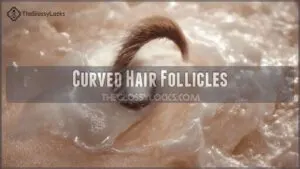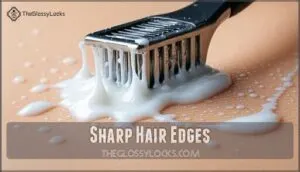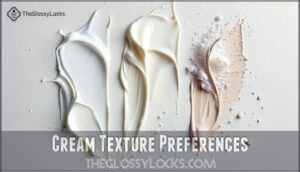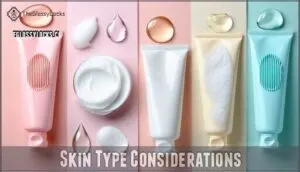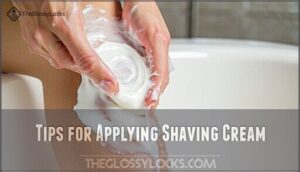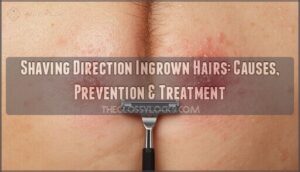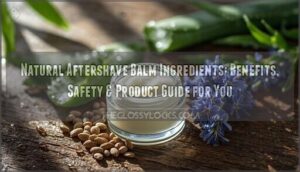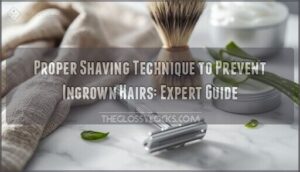This site is supported by our readers. We may earn a commission, at no cost to you, if you purchase through links.
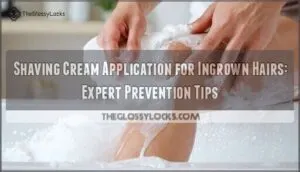 Proper shaving cream application for ingrown hairs starts with choosing a quality cream that creates a protective barrier between your razor and skin.
Proper shaving cream application for ingrown hairs starts with choosing a quality cream that creates a protective barrier between your razor and skin.
Apply the cream in circular motions, working it into a rich lather that covers all areas you’ll shave.
Let it sit for 30-60 seconds – this softens hair and helps follicles stand upright, preventing those annoying bumps that pop up later.
The key is coverage and patience, as these elements are crucial for a smooth shave.
Think of shaving cream as your skin’s bodyguard, reducing friction and preventing hair from being cut at sharp angles that curl back into follicles.
The right technique transforms your routine from razor burn roulette into smooth sailing.
Table Of Contents
- Key Takeaways
- Understanding Ingrown Hairs
- Causes of Ingrown Hairs
- Shaving Cream Selection
- Tips for Applying Shaving Cream
- Post-Shave Care for Ingrown Hairs
- Frequently Asked Questions (FAQs)
- What helps draw out an ingrown hair?
- Does shaving cream help with ingrown hair?
- Is there a cream to draw out ingrown hairs?
- What do you put on ingrown hairs after shaving?
- How to draw out ingrown hair?
- What benefits does shaving cream provide for ingrown hairs?
- Which ingredients help prevent ingrown hairs?
- How often should shaving cream be used for ingrown hairs?
- Are there any side effects or precautions to consider?
- What are some alternative treatments for ingrown hairs?
- Conclusion
Key Takeaways
- You’ll prevent ingrown hairs by applying shaving cream in circular motions and letting it sit for 30-60 seconds to soften hair follicles and create a protective barrier between your razor and skin.
- You should choose natural ingredient formulas with salicylic acid or glycolic acid that match your skin type – thick creams for coarse hair, lighter textures for fine hair, and hypoallergenic options for sensitive skin.
- You can’t draw out existing ingrown hairs with cream, but you’ll reduce future ones by using warm water prep, avoiding skin stretching while shaving, and maintaining sharp razor blades to prevent jagged cuts.
- You’ll need consistent post-shave care including cool water rinses, moisturizing with glycerin-based products, gentle exfoliation 2-3 times weekly, and wearing loose clothing to prevent friction and irritation.
Understanding Ingrown Hairs
Despite your best Hair Removal Methods, ingrown hairs happen when your hair follicle plays tricks on you.
Instead of growing outward, the hair curls back into your skin, creating those frustrating bumps that scream "Ingrown Hair Symptoms."
High-Risk Areas like your face, neck, and bikini line are particularly vulnerable to this skin irritation.
Think of it as your hair taking a U-turn when it should go straight.
The right shaving cream becomes your ally in Preventing Complications and achieving Ingrown Hair Relief through proper hair removal technique.
Shaving against the grain can exacerbate razor bump formation.
Causes of Ingrown Hairs
You’ve probably wondered why those annoying red bumps keep showing up after you shave, even when you think you’re doing everything right.
Understanding what causes ingrown hairs is the first step to preventing them, and it’s simpler than you might think—it all comes down to how your hair grows back and what happens to your skin during the shaving process.
Curved Hair Follicles
Your hair follicle shape determines your ingrown risk more than you’d think.
Curly hair naturally grows in curved patterns, creating a genetic predisposition for problems.
When follicle strength can’t support the hair’s natural hair curl, it turns inward instead of outward.
Quality shaving cream for ingrown hairs helps by softening hair and reducing this follicle-related resistance during removal.
Sharp Hair Edges
When your razor creates sharp, angled cuts, those blunt hair ends become tiny spears that can pierce back into your skin.
Poor razor sharpness leads to jagged cuts that increase ingrown hair risk.
Shaving direction matters too – going against the grain creates sharper angles.
Regular exfoliation helps prevent razor bumps by clearing pathways for proper angled hair growth.
Skin Pulling While Shaving
Pulling your skin tight creates a deceptively smooth surface, but you’re actually cutting hair below skin level.
Stretching skin while shaving creates a trap—hair gets cut too short and retreats beneath the surface.
When you release that tension, shortened hair retreats beneath the surface, setting up perfect conditions for razor bumps. Skin elasticity varies, making some people more vulnerable to this shaving technique trap.
A key factor can be dead skin clogging follicles, which traps the hair.
Here are three technique adjustments to prevent this issue:
- Lubrication importance: Apply quality shaving cream generously before any blade contact
- Pre-shave prep: Soften whiskers with warm water for easier cutting
- Razor sharpness: Sharp blades require less pressure, reducing skin irritation
Shaving Cream Selection
You’ll find that choosing the right shaving cream makes the difference between smooth skin and angry red bumps that look like you wrestled with a particularly vindictive cactus.
The cream you select acts as your skin’s protective barrier, reducing friction and softening hair follicles to prevent those pesky ingrown hairs from forming in the first place, which is crucial for achieving smooth skin.
Natural Vs. Synthetic Ingredients
Looking at shaving cream ingredients can make or break your battle against ingrown hairs.
Natural ingredients like tea tree oil and coconut oil reduce skin sensitivity while providing superior ingredient efficacy. Synthetic formulations often trigger more skin irritation and environmental impact concerns.
For a gentler shave, many are turning to eco friendly shave cream with organic ingredients.
Consider these emotional benefits of natural shaving cream ingredients:
- Peace of mind knowing you’re avoiding harsh chemicals
- Confidence in gentler, skin-loving botanicals
- Relief from reduced inflammation and irritation
Cream Texture Preferences
You’ll find that cream thickness dramatically impacts your shaving experience and ingrown hairs prevention.
Dense formulations create superior protection, while lighter textures allow closer razor contact.
Consider your application ease preferences and skin feel needs when selecting shaving cream for sensitive skin.
Gels are highly concentrated, offering maximum skin hydration but can clog razor blades.
| Texture Type | Protection Level | Best For |
|---|---|---|
| Thick Cream | Maximum | Coarse Hair |
| Medium Foam | Moderate | Daily Use |
| Light Lotion | Basic | Fine Hair |
Skin Type Considerations
How do you choose the right shaving cream when your skin seems to have its own personality?
Sensitive skin craves hypoallergenic, fragrance-free formulas that won’t throw a tantrum.
Dry skin thirsts for glycerin-rich creams with natural oils like shea butter.
Oily skin prefers lightweight, non-comedogenic options that won’t clog pores.
Combination skin needs balanced formulations addressing multiple zones.
Acne-prone skin benefits from salicylic acid-infused creams preventing breakouts.
Your skin type determines everything—from texture preferences to active ingredients.
Finding the right product means exploring options for sensitive skin.
Choose dermatologist-tested shaving cream for sensitive skin that addresses your concerns and prevents ingrown hairs effectively.
Tips for Applying Shaving Cream
Mastery in shaving cream application transforms your daily routine from a potential minefield into smooth sailing. The difference between razor burn and baby-soft skin often comes down to technique, not just product choice.
Start with Pre-Application Prep by thoroughly wetting your skin with warm water for 10-15 minutes. This softens hair follicles and opens pores, creating the perfect canvas for your shaving cream. Apply a generous, even layer while your skin’s still damp—never bone dry.
Here’s your game-changing approach for Layering Shaving Cream:
- Work in circular motions to massage cream deep into hair follicles
- Let it sit for 1-2 minutes before shaving to maximize hair softening
- Maintain moisture by reapplying if the cream starts drying out
Remember, you’re creating a protective barrier between razor and skin. Selecting the best shaving cream can substantially improve this barrier. This simple step prevents those angry red bumps that’ll have you looking like a plucked chicken.
Post-Shave Care for Ingrown Hairs
After you’ve finished shaving, your skin needs TLC to prevent those annoying ingrown hairs from crashing the party.
Start with soothing balms containing aloe or chamomile to calm irritation. Here’s your post-shave game plan:
| Step | Product Type | Key Benefits |
|---|---|---|
| Rinse | Cool water | Closes pores, reduces inflammation |
| Apply | Moisturizing ingredients like glycerin | Hydrates and softens skin barrier |
| Exfoliate | Gentle scrub (2-3x weekly) | Prevents dead skin buildup |
| Dress | Loose clothing | Reduces friction and irritation |
| Monitor | Daily skin check | Early detection of issues |
Using balms with ingredients like tea tree oil can further help to prevent clogged pores.
Remember: consistent exfoliation frequency and proper moisturizing skin habits are your best defense against ingrown hairs.
Frequently Asked Questions (FAQs)
What helps draw out an ingrown hair?
While picking seems tempting, don’t!
Warm compresses soften skin, allowing trapped hairs to surface naturally.
Gentle exfoliation with salicylic acid removes dead cells blocking the follicle.
Tea tree oil reduces inflammation while you wait patiently.
Does shaving cream help with ingrown hair?
Shaving cream can help prevent ingrown hairs by providing lubrication that reduces friction and irritation.
Choose creams with salicylic acid or glycolic acid—they’ll exfoliate while you shave, keeping those pesky hairs from curling back.
Is there a cream to draw out ingrown hairs?
You can’t really "draw out" ingrown hairs with cream, but topical treatments help. Try salicylic acid or glycolic acid products to exfoliate dead skin cells and free trapped hairs naturally.
What do you put on ingrown hairs after shaving?
Studies show 60% of people who shave develop ingrown hairs regularly.
After shaving, you’ll want to apply alcohol-free moisturizer with salicylic acid, then use soothing aftershave balm containing witch hazel or aloe vera.
How to draw out ingrown hair?
Apply warm compresses for 10-15 minutes to soften skin and encourage the hair to surface.
Gently exfoliate with a soft brush or washcloth.
Don’t pick or squeeze—let the hair emerge naturally to avoid infection.
What benefits does shaving cream provide for ingrown hairs?
Quality shaving cream softens your hair and creates a protective barrier between your razor and skin.
It reduces friction, prevents irritation, and helps you achieve a closer shave without the bumps.
Which ingredients help prevent ingrown hairs?
Don’t put all your eggs in one basket when choosing shaving products.
You’ll want salicylic acid, glycolic acid, and tea tree oil to unclog pores.
Plus moisturizing ingredients like aloe vera to reduce friction and irritation.
How often should shaving cream be used for ingrown hairs?
Use shaving cream every time you shave to prevent ingrown hairs.
Don’t skip it—even for quick touch-ups.
The protective barrier it creates reduces friction and irritation, keeping those pesky bumps at bay.
Are there any side effects or precautions to consider?
Gentle cleansing routines can occasionally cause mild irritation or dryness. You’ll want to patch-test new products first, avoid over-exfoliating sensitive areas, and discontinue use if redness or burning occurs unexpectedly.
What are some alternative treatments for ingrown hairs?
You’ve got several options beyond traditional treatments.
Try laser hair removal for permanent reduction, chemical peels with glycolic acid, or professional extraction.
Waxing, sugaring, and epilating can also help break the ingrown cycle.
Conclusion
Mastering shaving cream application for ingrown hairs is like learning to drive smoothly instead of hitting every pothole.
You’ve now got the roadmap: choose quality cream, apply in circles, wait patiently, and let it work its magic.
Your skin will thank you with fewer bumps and irritation.
Remember, proper technique beats expensive products every time.
Take these steps seriously, and you’ll transform your daily shave from a dreaded chore into a confident, comfortable routine that actually protects your skin.

